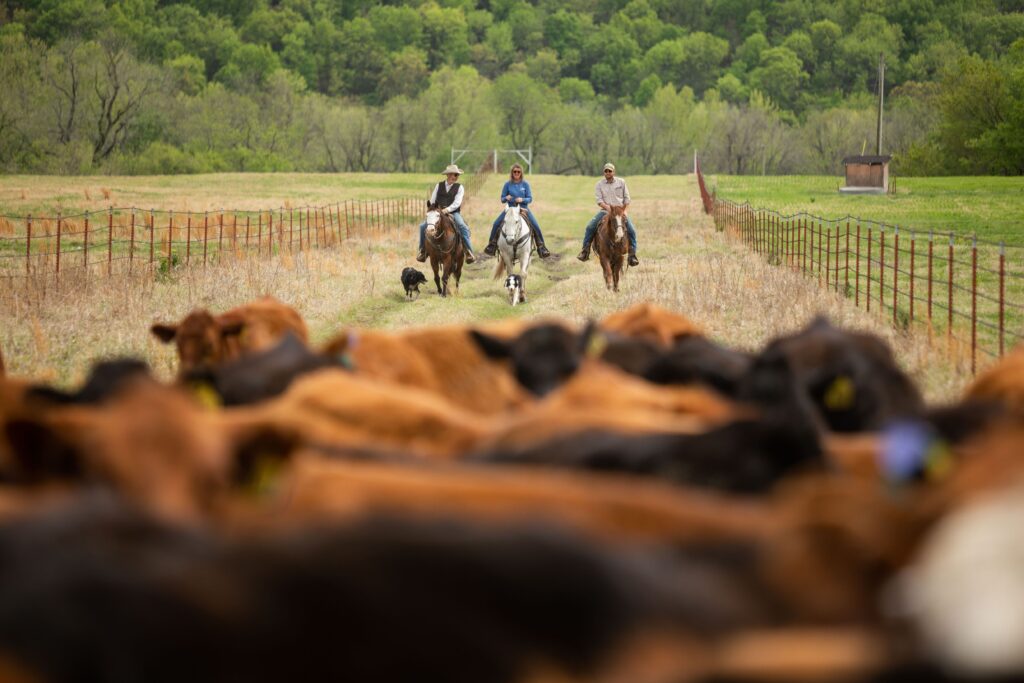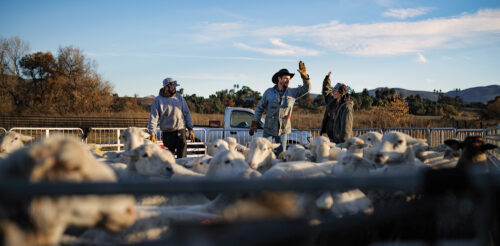Choosing Nature’s Calving Season
Noble Ranches have increased cow-calf enterprise gross margins by shifting spring calving two months later.
Earlier this winter, I was reviewing the economic details of our Noble Ranches with Joe Pokay, our general ranch manager at Noble Research Institute. We thought it might be informative and helpful to share our reflections on the gross margins of our cow-calf operations and the changes we made that have led to our cow herds’ increased profitability.
In 2021, Noble set its direction on grazing-land soil health, application of regenerative grazing management and lasting profitability. Noble is fully committed to regenerative ranching on the 13,500 acres that comprise the Noble Ranches, which are managed as six separate ranches with a ranch manager at each location. Pokay oversees and manages the collective operations of the ranches.
For decades, Noble’s ranches calved during the winter months. Cows were bred to calve in February and March, with heifers bred to calve in January, which meant calves usually started arriving during the Christmas season.
In 2021, we moved our breeding season two months later than the previous year to calve more in sync with nature. Our objective was to begin calving in the spring (March-May) when there is ample green and growing forage for cows to graze during lactation – their highest period of nutritional demand. This also complements the land because our forage growth rate in the spring usually exceeds the grazing utilization rate.
In addition, our regenerative management practices include adaptive multi-paddock, high stock density grazing; monitoring and adjusting stocking rate to actual forage production throughout the year; not applying fertilizer and herbicide to pastures; and using cover crop mixtures as forage crops on introduced pastures.
Before we made the decision to change calving seasons, we had to ask ourselves some tough questions.
Why are we calving in the middle of winter?
The easy answer was, “That’s what we have always done.” However, there is a history that influenced our practice, especially as it pertains to the Southern Great Plains. In the late 1950s, the winter pasture stocker program developed in our region and transformed many wheat fields into grazing pastures for stocker calves, which encouraged producers to wean a calf that fit this system. That meant weaning and selling a 500-pound calf to go on wheat pasture in late October or early November. This worked well during the 1960s, 1970s and 1980s.
By the 1990s, valued-added calf (VAC) programs were introduced, which paid producers a premium for calves that were preconditioned (weaned, vaccinated and placed on feed) for 21 to 30 days before marketing. Now, 45 days is the standard VAC program. The use of by-product feeds, which were less expensive than most marketed total mixed rations, became more popular during the 1990s and beyond, too. Producers began producing heavier calves and marketing more advantageously – seeking cost-effective preconditioning programs while marketing outside the typical fall calf market price slump.
The easy way to increase weaning weight is to make calves older at weaning and marketing times, which means either weaning and selling later or moving the calving season earlier a few weeks. Shifting calving ahead a few weeks over several years created a “spring” calving season beginning in January. In the process of moving the calving season, we simultaneously increased our need for hay and supplemental feed to the cow herd. This increased our direct costs for the cow-calf enterprises.
When feed and hay were less expensive, a little additional feeding could be economically feasible. However, today’s cost structure is different than it was 30 or 40 years ago. Calf prices have increased over time, but input costs have increased at a much greater rate. As an industry, we had lost focus on the gross margin (the difference between gross product and direct costs of an enterprise). We were placing too much attention on sale weights and gross revenues, which are both poor indicators of profitability.
What is the gross profit of the cow-calf enterprises of the ranches?
Gross margin, according to Ranching for Profit applied economics methodology, is gross product (gross revenue + net change in inventory value) – direct costs (feed and hay, veterinary/medical supplies, freight and marketing, and the opportunity cost on the value of the cow-calf enterprise).
In applying regenerative management, we strive to work with nature and feed as little hay as necessary. We set our stocking rate based on standing forage inventory to get us through winter and 30 days into spring. We make forage assessments monthly throughout the year to make stocking rate adjustments when we have excess or deficient standing forage supplies.
Historically, Noble planned to feed hay to the cows for three to four months plus supplemental feed, based on cattle nutritional requirements and forage analysis of hay. We also fertilized and weed-sprayed our bermudagrass and planted winter pasture forages based on soil analysis for maximum production. Since the transition to regenerative management, we mainly provide supplemental feed to complement the lack of protein in standing forage stockpiles, and we feed supplemental hay during extreme weather events.
The net result of this management change is that we run fewer cows, but the gross margin to the cow-calf enterprises has increased. One example is the change in our fed hay costs. Assuming a cow uses (eats and wastes) 3.5% of her body weight in hay, that equates to 42 pounds of hay a day (1,200 pounds x 3.5%). With hay in southern Oklahoma averaging $100 per ton ($60 for a 1,200-pound bale), feeding one cow hay for one day cost $2.10. We were feeding hay for 3.5 months, so the average hay cost per cow was $220 per head. Of course, that didn’t include the cost to feed the hay (fuel, labor, repairs, etc.), but only the cost of the hay itself.

Across an average cow herd of 500 head, the hay alone cost the operation $110,000 a year. When we asked ourselves how to increase profitability in our cow herd, we found the highest direct cost was fed feed (total of hay and supplemental feed plus salt and mineral). This discovery led to this conversation:
Why are we feeding so much hay?
Because they need it to maintain body condition, especially to be in shape for calving.
Why can’t they maintain body condition during calving?
The forage they are grazing lacks the nutritional value to meet their demands during the maintenance stage and especially during lactation after calving.
When does the forage supply enough nutrition to meet their lactation demand?
During the spring and early summer, when everything is actively growing again.
By moving the calving season to calve our herds when the forage can meet the cow’s demands (more in sync with nature), we can save the ranch from buying (or making) $220 per head worth of hay per cow. On Noble’s ranches, we have reduced our total feed cost by 31%. This reduction in feed contributes to our increasing gross margin in the cow herds that averaged more than $1,200 per cow in 2024.
More importantly, although our cow numbers have decreased during the past three years of prolonged drought, our profit per acre has steadily improved. This leaves much of the cow-calf enterprise’s gross margin to contribute toward the overhead costs (labor, equipment and repairs, land opportunity costs, depreciation) and provide for total ranch profitability.
What are the pros and cons of transitioning to calving in the middle of spring and not overstocking relative to forage production?
Pros: Much greater gross margin and enterprise profitability, feeding hay only in inclement weather, calves not at risk of being born during the extreme cold spells and snowstorms, less time outdoors during the winter extremes, less fuel and wear and tear on equipment, and more time in the winter to spend with family or doing business activities and planning. In addition, marketing our calves during the springtime “grass fever” for stocker operations usually proves to be favorable timing.
Cons: Calf marketing needs to be planned differently. When we calved in January, we would market an 11-month-old calf in December. Now that we calve in April, we need to plan (and budget) to market an 11-month-old calf in March. If we only moved our calving back and marketed our calves “when we always sell calves” in the fall, we would see less value per head because the calves are lighter.
Even though this timing also leaves us more time to do the ‘honey-dos’ we don’t really want to get to – we’ve found the pros outweighed the cons.
In summary, as Noble took a closer look at ranch profitability through our regenerative management lens, we discovered that there was much more money to be made through some management changes than we ever expected. One of those key management changes was moving our calving season from mid-winter to the middle of spring.
We also adopted a few complementary management changes, such as stocking to match forage production so that we do not have to feed hay, and having a well-managed adaptive grazing program. These management changes and shifting our calving season have improved both our profitability and our ranch staff’s quality of life.
Whether you are ranching regeneratively or not, you owe it to yourself to consider what calving in ‘true’ spring would do for your cow-calf enterprise’s profitability.
Editor’s Note: This is part of a continuing series of articles about regenerative ranching for the American Hereford Association. Follow the series in future issues of Baldy Advantage and Hereford World, as well as in special “1881” podcasts, at Hereford.org.



Comment